Excessive speed is one of the biggest killers on our roads. On average, 130 people die every year in New Zealand in speed-related crashes.
Remember, the faster you go, the more likely you are to be killed or seriously injured if you crash.
When driving a heavy vehicle you must ensure:
ImportantRemember to observe the four-second rule. |
If you are travelling slower than the speed limit and there are vehicles following you, you must:
Don’t speed up on straight stretches of road to prevent following vehicles from passing you.
A speed limit is the maximum legal speed that you can travel on the road under good conditions.
Signs showing the speed limit are displayed beside the road. These signs usually have a red border, which means that the sign is compulsory.
You may drive slower than the speed limit shown, but you must be considerate towards any vehicles behind you.
You must drive slower than the limit if:
Some examples of speed signs are shown below.
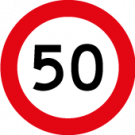
50 km/h speed sign
The maximum speed you can travel is 50km/h.
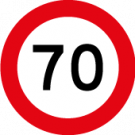
70km/h speed sign
The maximum speed you can travel is 70km/h.
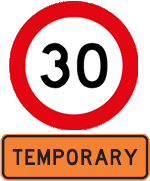
Temporary speed sign
A temporary speed limit of 30km/h applies. Temporary speed-limit signs are usually put up when there is work being done on or near the road.
The signs below mean that the maximum speed that a light vehicle can travel at is 100km/h. However, the maximum speed heavy vehicles can travel at is 90km/h (except for school buses, which are limited to 80km/h).
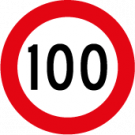
100 km/hr maximum speed sign
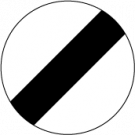
Derestriction speed sign
Maximum speed for heavy vehicles is 90km/h – 100km/h for light vehicles.
The vehicles listed in the table below have a lower maximum speed limit than light vehicles.
Vehicle type |
Maximum open road speed limit |
| Heavy vehicles (vehicles with a gross vehicle mass* of over 3500kg) and heavy motor vehicles towing trailers. This includes buses used principally to transport school children to and from a school function provided that all the passengers are seated. |
90km/h |
| Vehicles with a gross vehicle mass* of over 2000kg that are displaying school bus signs. |
80km/h |
| Heavy vehicles constructed without springs or other forms of suspension, between its road wheels and its chassis. |
45km/h |
* Gross vehicle mass (GVM) is the greater of:
ImportantSpeed-limit changes take effect at the sign post. Before reaching the speed-limit sign, make sure you:
|
Some schools display signs that are turned on before and after school and other times such as lunch time. Examples are shown below.

School zone speed sign
This sign will be displayed at the start of the school zone. If the 40 is visible and the yellow lights are flashing, the maximum speed is 40km/h until the zone ends.
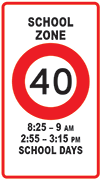
School zone speed sign
This sign will be on a side road.
ImportantIf a driver exceeds a permanent posted speed limit by more than 40km/h, there is an automatic 28-day licence suspension. If a driver exceeds a temporary speed limit by more than 50km/h, there is an automatic 28-day licence suspension. These 28-day suspensions are in addition to any other penalties imposed, eg licence disqualification and paying a fine. |
The signs below mean that you are coming up to a crash, breakdown, fire or other emergency. Slow down and drive at 20km/h or less until you have passed the emergency site.

Emergency sign

Emergency sign

Emergency sign

Emergency sign

Emergency sign

Emergency sign
The signs below are displayed on school buses. If a school bus has stopped you must slow down and drive at 20km/h or less until you are well past the bus (no matter what direction you are coming from), if:
School bus signs

School bus signs
Note: you may also see ‘Kura’, the Māori word for school, on a bus.
The signs below warn you that you are coming up to a tight curve or bend in the road. The number recommends a safe and comfortable speed to drive at around the curve – in this example, the recommended speed is 35km/h. The arrows show which direction the curve goes.
Note: the recommended speed is for a light vehicle and may be too fast for a heavy vehicle, particularly when laden. Drive carefully and adjust your speed if necessary. If you are carrying a load, reduce your speed on a curve to at least 10km/h below the posted speed shown.

Curve warning sign
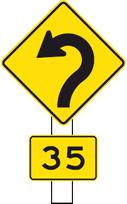
Curve warning sign
Variable speed signs are used to manage traffic congestion. You need to adjust your speed accordingly.
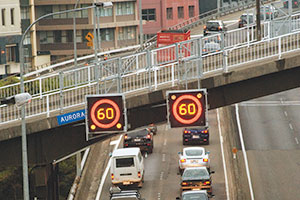
Variable speed signs
These speed limit signs can be used at beaches or rivers. If pedestrians are present, the speed limit is 30km/h. If there are no pedestrians, the speed limit is 60km/h.
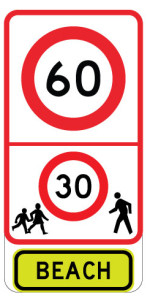
Keep it 10 belowA speed study of 188 trucks showed 86 percent of drivers took corners faster than the recommended speed. An analysis of truck crashes on the Kaikōura coast revealed 73 percent were rollovers at corners with advisory speed signs. |